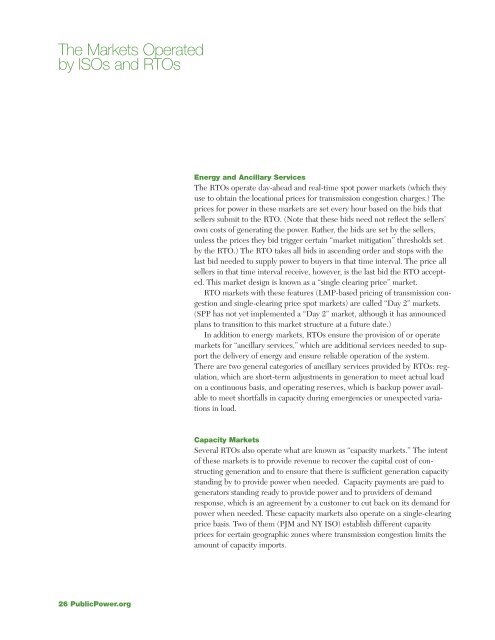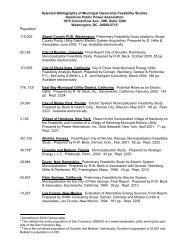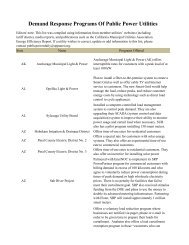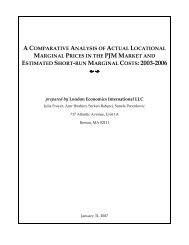2011 APPA Neophyte's Guide to Electricity - American Public Power ...
2011 APPA Neophyte's Guide to Electricity - American Public Power ...
2011 APPA Neophyte's Guide to Electricity - American Public Power ...
Create successful ePaper yourself
Turn your PDF publications into a flip-book with our unique Google optimized e-Paper software.
The Markets Operated<br />
by ISOs and RTOs<br />
Energy and Ancillary Services<br />
The RTOs operate day-ahead and real-time spot power markets (which they<br />
use <strong>to</strong> obtain the locational prices for transmission congestion charges.) The<br />
prices for power in these markets are set every hour based on the bids that<br />
sellers submit <strong>to</strong> the RTO. (Note that these bids need not reflect the sellers’<br />
own costs of generating the power. Rather, the bids are set by the sellers,<br />
unless the prices they bid trigger certain “market mitigation” thresholds set<br />
by the RTO.) The RTO takes all bids in ascending order and s<strong>to</strong>ps with the<br />
last bid needed <strong>to</strong> supply power <strong>to</strong> buyers in that time interval. The price all<br />
sellers in that time interval receive, however, is the last bid the RTO accepted.<br />
This market design is known as a “single clearing price” market.<br />
RTO markets with these features (LMP-based pricing of transmission congestion<br />
and single-clearing price spot markets) are called “Day 2” markets.<br />
(SPP has not yet implemented a “Day 2” market, although it has announced<br />
plans <strong>to</strong> transition <strong>to</strong> this market structure at a future date.)<br />
In addition <strong>to</strong> energy markets, RTOs ensure the provision of or operate<br />
markets for “ancillary services,” which are additional services needed <strong>to</strong> support<br />
the delivery of energy and ensure reliable operation of the system.<br />
There are two general categories of ancillary services provided by RTOs: regulation,<br />
which are short-term adjustments in generation <strong>to</strong> meet actual load<br />
on a continuous basis, and operating reserves, which is backup power available<br />
<strong>to</strong> meet shortfalls in capacity during emergencies or unexpected variations<br />
in load.<br />
Capacity Markets<br />
Several RTOs also operate what are known as “capacity markets.” The intent<br />
of these markets is <strong>to</strong> provide revenue <strong>to</strong> recover the capital cost of constructing<br />
generation and <strong>to</strong> ensure that there is sufficient generation capacity<br />
standing by <strong>to</strong> provide power when needed. Capacity payments are paid <strong>to</strong><br />
genera<strong>to</strong>rs standing ready <strong>to</strong> provide power and <strong>to</strong> providers of demand<br />
response, which is an agreement by a cus<strong>to</strong>mer <strong>to</strong> cut back on its demand for<br />
power when needed. These capacity markets also operate on a single-clearing<br />
price basis. Two of them (PJM and NY ISO) establish different capacity<br />
prices for certain geographic zones where transmission congestion limits the<br />
amount of capacity imports.<br />
26 <strong>Public</strong><strong>Power</strong>.org

















